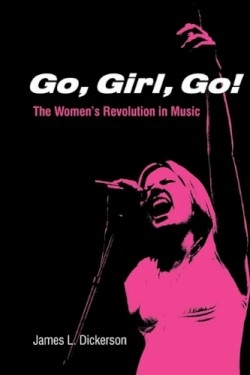Go, Girl, Go!
The Women's Revolution in Music
Popular music in America has been so much a man’s world that the author performs a real service here in drawing attention to the steady contributions and growing influence of women performers, songwriters, managers, and record company executives. The “revolution” he alludes to came to fruition in 1996, when substantially more women than men scored Top Twenty hits. Among these trailblazers were Madonna, Alanis Morissette, Mariah Carey, Shania Twain, Leann Rimes, and Celine Dion. But they achieved more than chart prominence; their massive record sales underscored their rising popularity.
Dickerson, a veteran journalist and author, has written ten other books, including biographies of the Dixie Chicks, Faith Hill, Nicole Kidman, Ashley Judd, and Colonel Tom Parker. He devotes a little more than half of this new volume to profiling women who were prominent in popular music (including country and rock) from 1900 through the 1980s. The remainder examines the ’90s upsurge.
A treasury of cameos and insights has been gleaned from the author’s interviews of such performers as Bobby Gentry (whom he played with when they were both children), Pat Benatar, Brenda Lee, Melissa Etheridge, Bonnie Raitt, Ann and Nancy Wilson, and Twain. Just as revealing are his conversations with backstage movers and shakers like Frances Preston, the powerful and diplomatic chief of the BMI performance rights organization; Renee Bell, who screens songs for RCA’s country music division; and Sandy Neese, Twain’s former publicist at Mercury Records.
However, one may argue about some of Dickerson’s omissions. He overlooks, for example, the importance of Kate Smith, not merely as a beloved performer during the World War II era but also as the hostess of a musically important postwar television show. He similarly passes over Barbara Mandrell, who was a major force in popularizing country music in the late ’70s and early ’80s, and the Judds, who, unlike most women in country music, achieved stardom without being groomed for it by a male mentor. Dickerson also makes the surprising and unsubstantiated assertion that “country music has always had a larger percentage of gay performers than country or rock.”
Still, some of Dickerson’s observations are profound, among them this one: “When male artists had hit records, they seemed to thrive on the success, using it as a stepping stone to even bigger things, but, invariably, when female artists had hits, it unleashed a barrage of professional and personal hurdles that few women were able to overcome.” Go, Girl, Go! is both informative and provocative.
Reviewed by
Edward Morris
Disclosure: This article is not an endorsement, but a review. The publisher of this book provided free copies of the book to have their book reviewed by a professional reviewer. No fee was paid by the publisher for this review. Foreword Reviews only recommends books that we love. Foreword Magazine, Inc. is disclosing this in accordance with the Federal Trade Commission’s 16 CFR, Part 255.

